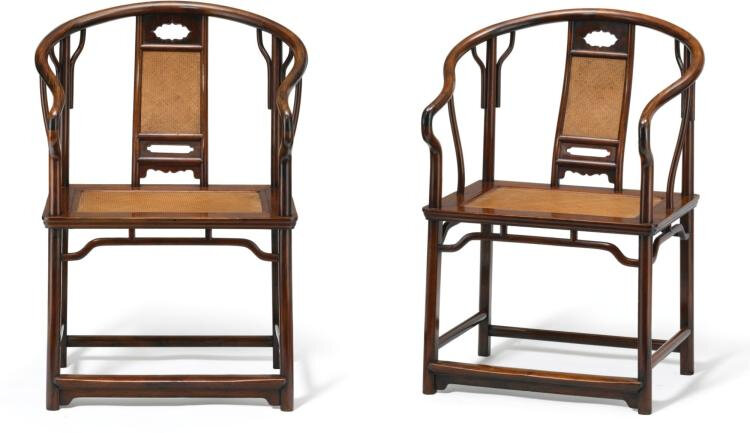A pair of huanghuali continuous horseshoe-back armchairs, Late Ming dynasty

Lot 104. A pair of huanghuali continuous horseshoe-back armchairs, Late Ming dynasty; 94 by 61.1 by 46 cm., 37 by 24 by 18 1/8 in. Estimate 1,300,000 — 2,500,000. Lot Sold 2,360,000 HKD (1,002,416 EUR). Courtesy Sotheby's.
each horseshoe-shaped arm of three sections joined by overlapping pressure-pegged scarf joins, the posts and stiles mortised and tennoned into the arm and extending through the seat frame as legs, two round curved stretchers tongue-and-grooved into both back stiles and tennoned into the underside of the arm forming catapult-shaped supports, the back splat formed by two shaped uprights, mortised and tennoned into the underside of the arm and the back of the seat frame, flanking three mitred horizontal stretchers dividing the back splat into four main registers, the top inset with an openwork panel with a beaded edge, the second with a mat-on-board panel, the third with a further beaded-edged openwork panel, all above a cusped apron with a beaded edge, the arms supported on each side with an elongated round S-shaped brace, the seat frame of mitre, mortise and tenon construction supported with one transverse stretcher underneath, the shorter rails with exposed tenons, hump-back-shaped stretchers with pillar-shaped struts joining the legs below the seat frame, above oval stretchers with flattened undersides joining the side and back legs near the feet and a shaped footrest at the front atop an apron.
Exhibited: Grace Wu Bruce, Dreams of Chu Tan Chamber and the Romance with Huanghuali Wood: The Dr. S. Y. Yip Collection of Classic Chinese Furniture, Art Museum, Chinese University of Hong Kong, Hong Kong, 1991, cat. no. 5, pp. 30-31.
The Chinese Collections, Asian Civilisations Museum, Singapore, 1997-99.
Freer Gallery of Art and Arthur M. Sackler Gallery, Smithsonian Institution, Washington D.C., 2000-02.
Grace Wu Bruce, Grace Wu Bruce presents a choice selection of Ming Furniture from the Dr. S.Y. Yip collections, Hong Kong Convention and Exhibition Centre, Hong Kong, 2012, pp. 36-37.
Literature: Huang Cuiwen, 'Mingchao muyi [Wooden chair of the Ming dynasty]', Esquire, Autumn 1988, p. 30.
Yip Shing Yiu, 'Collecting Ming Furniture of Huang Hua-Li Wood', Arts of Asia, May-June 1991, p. 119, fig. 2.
Note: "This pair was my first acquisition in 1988 that began my journey into Ming furniture. The simple struts are magnificent, and the inlaid mat into the back splat with open work is probably meant for use in Southern China. Never will you find a second piece like it."
One of the three main types of Ming chairs, the horseshoe-back design is uniquely Chinese and has inspired various twentieth century furniture designers to create well-known modern examples. This pair of chairs, due to their continuous arm-post construction, belongs to a rarer type of horseshoe-back armchairs.
Other special features include the catapult-shaped spandrels on the stiles and the four-part back splat with a caned central section. These chairs, in rich brown colour and dense grain, are made of huanghuali of the best variety.
Section-back Ming chairs are known but there is no similar caned-back horseshoe-back armchair in published examples to date. The 'catapult-shaped' spandrels below the arm are also very rare, the only other known examples are the horseshoe-back armchairs in the collection of the Nelson-Atkins Museum of Art, Kansas City, illustrated in Robert Hatfield Ellsworth, Chinese Furniture: Hardwood Examples of the Ming and Early Ching Dynasties, New York, 1971, pl. 16.
Sotheby's. Ming Furniture – The Dr S Y Yip Collection, Hong Kong, 07 October 2015

/https%3A%2F%2Fprofilepics.canalblog.com%2Fprofilepics%2F1%2F0%2F100183.jpg)
/https%3A%2F%2Fstorage.canalblog.com%2F03%2F02%2F119589%2F96711876_o.jpg)
/https%3A%2F%2Fstorage.canalblog.com%2F11%2F31%2F119589%2F94773502_o.jpg)
/https%3A%2F%2Fstorage.canalblog.com%2F20%2F83%2F119589%2F94772815_o.jpg)
/https%3A%2F%2Fstorage.canalblog.com%2F26%2F72%2F119589%2F75604929_o.jpg)
/https%3A%2F%2Fstorage.canalblog.com%2F59%2F60%2F119589%2F26458628_o.jpg)



/image%2F1371349%2F20240409%2Fob_fc01a6_2024-nyr-22642-0899-000-a-rare-small-h.jpg)
/image%2F1371349%2F20240409%2Fob_1299ed_2024-nyr-22642-0898-000-a-rare-huanghu.jpg)
/image%2F1371349%2F20240403%2Fob_b08891_telechargement-4.jpg)
/image%2F1371349%2F20240403%2Fob_b24488_telechargement.jpg)